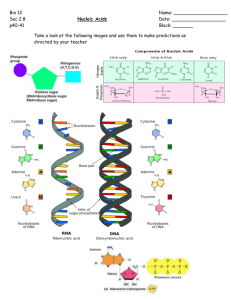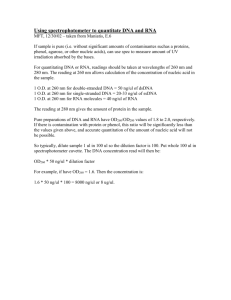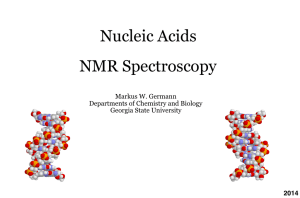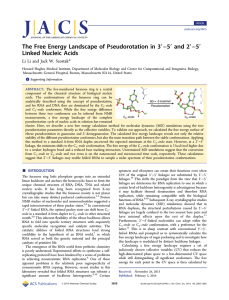Talk_12_Nucleic_Acids
advertisement
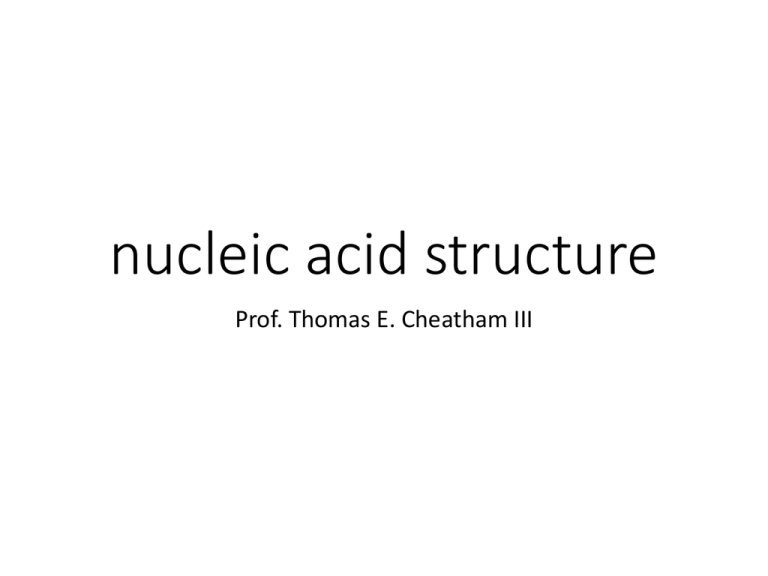
nucleic acid structure Prof. Thomas E. Cheatham III Where art thou nucleic acid? N 5’GUCUGGCAUUGGGAUUCGGGUUUCUCAGAAACUUGGAU UUCUAACCUGAAAAAUCACUUUCGGGGACCGUGCUUGGC -3’ N O N H + H2N NH + NH2 NH2 ? ? Our long-term goals are to enable the end-stage of nucleic acid structure refinement, to accurately model nucleic acid structure and dynamics, and to probe the interaction of molecules targeting RNA and DNA. Given a putative RNA model can we refine it? Can we evaluate its relative importance? Can we probe the interaction with other molecules / drugs? H2N A nucleotide has three parts: Base NH 2 N N Phosphate N O -O P O O H O- H H H OH OH Sugar N DNA and RNA have different sugars: Base NH2 N Phosphate N O -O P O N N O H O- Base H H NH2 H OH OH N Sugar = ribose RNA N Phosphate N O -O P O O O- H H OH H H H Sugar = deoxyribose DNA N The sugar-phosphate backbone AMBER names and atom types (parm94.dat) thymine adenine N7 N9 N7 N9 N3 guanine N6 N3 O2 N1 N2 O4 N1 N3 N1 O2 C3’ N4 N3 C2 N1 O4’ O2 C1’ cytosine C4’ 03’ C4’ C2’ C3’ O2’ C5’ P Sugar puckering Various sugar ring puckering conformations. Those on the left are denoted S (for south); those on the right, N (for north). The C3′-endo conformation is seen at the top right, and the C2′-endo conformation at the top left. The notation of E and T conformations is also given Sugar puckering Purines and pyrimidines The glycosidic torsion parameter Watson-Crick base pairing A-DNA and B-DNA form helices Base stacking Base pair and base pair step helicoidals Moving on to RNA The two types of sugar pucker most commonly found in nucleic acids. The C3′-endo pucker is prevalent in RNA and A-form DNA, whereas the C2′-endo pucker is characteristic of B-form DNA. It is seen that the C3′-endo pucker produces a significantly shorter phosphate-phosphate distance in the backbone, resulting in a more compact helical conformation. RNA has more base pairing possibilities (DNA also has alternative base pairs) Left: Canonical Watson–Crick GC base pair (cis). Right: GC reverse Watson–Crick base pair (trans). Structures of base pairs involving at least two hydrogen bonds. The 28 possible base pairs that involve at least two hydrogen bonds as compiled by I. Tinoco Jr. Watson-Crick, Reverse Watson-Crick, Hoogsteen, Reverse Hoogsteen, Wobble, Reverse Wobble The ten possible purine-pyrimidine base pairs The seven possible homo purine-purine base pairs The seven possible pyrimidine-pyrimidine base pairs The four possible hetero purine-purine base pairs Ignacio Tinoco, Jr. in Gesteland, R. F. and Atkins, J. F. (1993) THE RNA WORLD. Cold Spring Harbor Laboratory Press. H H R N H N N N H N N N H R R cisWCWC H N N R N N N H R N N N N H N H N R H N H N N H H N N H N H N N N H N N H N N R H N H N H transHH H H N N R N H N N H transWCSh H N H N transWCWC cisWCH(b) H N N N R H Single H-bonded AA base pairs R N H N N H N H N H H N N H N H N H N R cisWCH(a) H H R N N H N H H R transHSh H N N H transWCH R H N H N N H N H N N H N H H N N N N H H H N N H N N R N H N H N H N H H cisWCSh R H H R N H cisHH H N H N N R H N N N N H N H R N H N N H N N N H H H N N H H H N N N H N N H H H N H R RNA uses chemically modified bases conformational selection vs. induced fit (in helix recognition) are the force fields reliable? (free energetics, sampling, dynamics) NMR structures of DNA & RNA all tetraloops crystal simulations RNA motifs quadruplexes RNA-drug interactions Computer power? energy experimental “reaction coordinate” vs. What we typically find if we run long 100 independent simulations of 2KOC “UUCG” tetraloop …longer runs… Limited sampling & too complex: Is there a simpler set of systems? Convergence as a function of time We can converge a tetranucleotide! How about a RNA tetraloop? Tutorial time!


